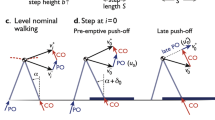Abstract
Rhythmic movements of a five-link sagittal biped with muscle-likeactuators are considered. In walking, as the support phases changecontact is periodically made with the environment. The inputs toevery actuator are modeled after the inputs to muscles in mammals. Thesystem possesses intrinsic position and velocity feedback due to theactuator dynamics. A control strategy is articulated that is novelin that it; a) is physiologically viable; b) simplifies the dynamics;and c) adapts to the speed of walking, going up and down stairs,going up or down inclines, maneuvering over obstacles or holes, andthe tempo and stride length of walking. Walking simulations of afive-link sagittal biped are presented.
Similar content being viewed by others
Explore related subjects
Discover the latest articles and news from researchers in related subjects, suggested using machine learning.References
Bizzi, E., Accornero, N., Chapple, W., and Hogan, N. 1984. Postural control and trajectory formation during arm movements. Journal of Neuroscience, 4:2738–2744.
Brooks, Vermon B. 1986. The Neural Basis of Motor Control, Oxford University Press: New York.
Dinneen, J.A. and Hemami, H. 1993. Stability and movement of a one-link neuro-musculo-skeletal sagittal arm. IEEE Transactions on Biomedical Engineering, 40(6):541–548.
Georgopoulos, A.P., Caminiti, R., Kalaska, J., and Massey, J. 1983. Spatial coding of movement: A hypothesis concerning the coding of movement direction by motor cortical populations. Experimental Brain Research, 7:327–336.
Georgopoulos, A.P. and Massey, J.T. 1988. Cognitive spatial motor processes. Experimental Brain Research, 69:315–326.
Hannaford, B. and Stark, L. 1985. Roles of the elements of the triphasic control signal. Exp. Neurology, 90:619–634.
He, J., Levine, W.S., and Loeb, G.E. 1991. Feedback gains for correcting small perturbations to standing posture. IEEE Transactions on Automatic Control, 38(3):322–332.
Hemami, H. 1980. A feedback on-off model of biped dynamics. IEEE Transactions on Systems, Man, and Cybernetics, smc-10(7):541–548.
Hemami, H. and Farnsworth, R.L. 1977. Postural and gait stability of a planar five-link biped by simulation. IEEE Transactions on Automatic Control, AC-22(3):452–458.
Hemami, H. and Wyman, B. 1979. Modeling and control of constrained dynamic systems with application to biped locomotion in the frontal plane. IEEE Transactions on Automatic Control, 24:526–535.
Hemami, H. and Wyman, B. 1980. Indirect control of the forces of constraint in dynamic systems. Journal of Dynamic Systems, Measurement and Control, 101:355–360.
Hemami, H. and Zheng, Y.F. 1983. Dynamics and control of motion on the ground and in the air with application to biped robots. Journal of Robotic Systems, 1(1):101–116.
Hemami, H. and Dinneen, J. 1993. A marionette-based control strategy for stable movement. IEEE Transactions on Systems, Man and Cybernetics, 23(2):502–511.
Hemami, H. and Dinneen, J. 1995. Simple direction-dependent rhythmic movements and partial somesthesis of a marionette. IEEE Transactions on Systems, Man and Cybernetics, 25(11):1491–1500.
Herman, R., Cook, T., Cozzens, B., and Freedman, W. 1987. Control of postural reactions in man: The initiation of gait. Control of Posture and Locomotion, R.B. Stein, K.G. Pearson, R.S. Smith, and J.B. Redford (Eds.), Plenum Press: New York, NY.
Hogan, N. 1984. An organizing principle for a class of voluntary movements. Journal of Neuroscience, 4:2745–2754.
Hogan, N. 1985. The mechanics of multi-joint posture and movement control. Biological Cybernetics, 52:315–331.
Horstmann, G.A. and Dietz, V. 1990. The basic posture control mechanism: The stabilization of the center of gravity. Electroencephalography and Clinical Neurophysiology, 76:165–176.
Houk, J.C. 1980. Homeostasis and control principles. Medical Physiology, V.B. Mountcastle (Ed.), V.V. Mosby Co.: St. Louis, Chap. 8.
Inman, V.T. 1981. Human Walking, Williams and Wilkins: Baltimore, MD, first edition.
Iqbal, K., Hemami, H., and Simon, S.R. 1992. Stability and control of a frontal four-link biped system. IEEE Transactions on Biomedical Engineering, 40(10):1007–1018.
Kadaba, M.P., Ramakrishnan, H.K., Wootten, M.E., Gainey, J., Gorton, G., and Cochran, G.V.B. 1989. Repeatability of kinematic, kinetic, and electromyographic data in normal adult gait. Journal of Orthopaedic Research, 7:849–864.
Klein, C. and Huang, C. 1983. Review of pseudoinverse control for use with kinematically redundant manipulators. IEEE Transactions on Biomedical Engineering, 33(9):829–838.
Massey, J.T. and Georgopoulos, A.P. 1986. On information processing and performing a movement sequence. Experimental Brain Research, 15:242–251.
Onyshko, S. and Winter, D.A. 1979. A mathematical model for the dynamics of human locomotion. Journal of Biomechanics, 13(1):361–368.
Winter, D.A. 1987. The Biomechanics and Motor Control of Human Gait, University of Waterloo Press: Waterloo, Ontario (Canada), first edition.
Yamaguchi, Gary T. and Zajac, Felix E. 1990. Restoring unassisted natural gait to paraplegics via functional neuromuscular stimulation: A computer simulation study. IEEE Transactions on Biomedical Engineering, 37(9):886–902.
Author information
Authors and Affiliations
Rights and permissions
About this article
Cite this article
Jalics, L., Hemami, H. & Clymer, B. A Control Strategy for Terrain Adaptive Bipedal Locomotion. Autonomous Robots 4, 243–257 (1997). https://doi.org/10.1023/A:1008839925389
Issue Date:
DOI: https://doi.org/10.1023/A:1008839925389




